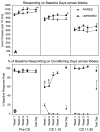Discrete cues paired with naloxone-precipitated withdrawal from acute morphine dependence elicit conditioned withdrawal responses
- PMID: 16571999
- PMCID: PMC2266687
- DOI: 10.1097/00008877-200605000-00002
Discrete cues paired with naloxone-precipitated withdrawal from acute morphine dependence elicit conditioned withdrawal responses
Abstract
Acute bolus doses of morphine induce a state of acute opioid dependence as measured by naloxone-precipitated withdrawal. Repeated morphine and precipitated withdrawal experience further enhances naloxone-induced withdrawal severity, partly because of direct neuroadaptation to repeated morphine, and partly because of conditioned associations of context and withdrawal experience. To determine whether a discrete tone/light conditioned stimulus could elicit conditioned withdrawal responses in acute dependence, rats trained on a fixed-ratio-15 operant schedule for food reward received morphine (5.6 mg/kg) 4x at daily or weekly intervals, with each morphine injection followed at 4 h by naloxone (1.0 mg/kg) and an operant session. The conditioned stimulus was presented to a Paired group after each naloxone injection. Separate control groups experienced the conditioned stimulus either at a different time of the day or on a different day of the week than naloxone (Unpaired), received naloxone without any conditioned stimulus exposure [Paired-no conditioned stimulus (Paired-NO CS)] or received vehicle instead of naloxone before conditioned stimulus presentation (NaI-Naive). On the test day, all rats received vehicle before conditioned stimulus exposure. The conditioned stimulus alone reliably suppressed responding in Paired groups relative to control conditions with either daily or weekly intervals between conditioning sessions. The administration of morphine 4 h before conditioned stimulus exposure on the test day was not necessary to observe conditioned withdrawal. Thus, conditioned withdrawal is reliably established to discrete cues associated with naloxone-precipitated withdrawal from acute, infrequent (weekly) opioid exposure.
Figures



Similar articles
-
Conditioning processes contribute to severity of naloxone-precipitated withdrawal from acute opioid dependence.Psychopharmacology (Berl). 2004 Oct;175(4):463-72. doi: 10.1007/s00213-004-1843-5. Psychopharmacology (Berl). 2004. PMID: 15083263
-
Repeated experience with naloxone facilitates acute morphine withdrawal: potential role for conditioning processes in acute opioid dependence.Pharmacol Biochem Behav. 2003 Dec;76(3-4):493-503. doi: 10.1016/j.pbb.2003.09.006. Pharmacol Biochem Behav. 2003. PMID: 14643849
-
Effects of high-dose selegiline on morphine reinforcement and precipitated withdrawal in dependent rats.Behav Pharmacol. 2005 Feb;16(1):1-13. doi: 10.1097/00008877-200502000-00001. Behav Pharmacol. 2005. PMID: 15706133
-
Brain reward deficits accompany naloxone-precipitated withdrawal from acute opioid dependence.Pharmacol Biochem Behav. 2004 Sep;79(1):101-8. doi: 10.1016/j.pbb.2004.06.006. Pharmacol Biochem Behav. 2004. PMID: 15388289
-
Conditioned place aversion is a highly sensitive index of acute opioid dependence and withdrawal.Psychopharmacology (Berl). 2003 Oct;170(1):42-50. doi: 10.1007/s00213-003-1514-y. Epub 2003 May 29. Psychopharmacology (Berl). 2003. PMID: 12783156
Cited by
-
Noradrenergic synaptic function in the bed nucleus of the stria terminalis varies in animal models of anxiety and addiction.Neuropsychopharmacology. 2013 Aug;38(9):1665-73. doi: 10.1038/npp.2013.63. Epub 2013 Apr 3. Neuropsychopharmacology. 2013. PMID: 23467277 Free PMC article.
-
Relative potency of the opioid antagonists naloxone and 6-alpha-naloxol to precipitate withdrawal from acute morphine dependence varies with time post-antagonist.Pharmacol Biochem Behav. 2009 Mar;92(1):157-63. doi: 10.1016/j.pbb.2008.11.007. Epub 2008 Nov 24. Pharmacol Biochem Behav. 2009. PMID: 19061911 Free PMC article.
-
Extinction of conditioned opiate withdrawal in rats in a two-chambered place conditioning apparatus.Nat Protoc. 2012 Feb 23;7(3):517-26. doi: 10.1038/nprot.2011.458. Nat Protoc. 2012. PMID: 22362157 Free PMC article.
-
Advances in the characterization of negative affect caused by acute and protracted opioid withdrawal using animal models.Neuropharmacology. 2023 Jul 1;232:109524. doi: 10.1016/j.neuropharm.2023.109524. Epub 2023 Mar 30. Neuropharmacology. 2023. PMID: 37003572 Free PMC article. Review.
-
Precipitated and conditioned withdrawal in morphine-treated rats.Psychopharmacology (Berl). 2010 Mar;209(1):85-94. doi: 10.1007/s00213-009-1773-3. Epub 2010 Feb 3. Psychopharmacology (Berl). 2010. PMID: 20127077 Free PMC article.
References
-
- Adams JU, Holtzman SG. Pharmacologic characterization of the sensitization to the rate-decreasing effects of naltrexone induced by acute opioid pretreatment in rats. J Pharmacol Exp Ther. 1990;253:483–9. - PubMed
-
- Anagnostaras SG, Gale GD, Fanselow MS. Hippocampus and contextual fear conditioning: recent controversies and advances. Hippocampus. 2001;11:8–17. - PubMed
-
- Azar MR, Jones BC, Schulteis G. Conditioned place aversion is a highly sensitive index of acute opioid dependence and withdrawal. Psychopharmacology (Berl) 2003;170:42–50. - PubMed
-
- Azorlosa JL, Stitzer ML, Greenwald MK. Opioid physical dependence development: effect of single versus repeated morphine pretreatments and of subjects’ opioid exposure history. Psychopharmacology (Berl) 1994;114:71–80. - PubMed
Publication types
MeSH terms
Substances
Grants and funding
LinkOut - more resources
Full Text Sources

